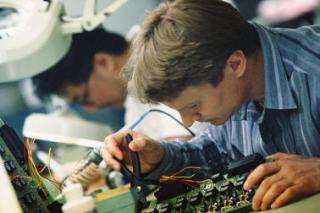Factory is where our computers eat up most energy

(PhysOrg.com) -- Home and office energy conservation must focus on more than developing computers, appliances and other electronics that require less power to operate. Engineers say there are big energy-efficiency gains to be achieved even before those products get plugged in.
The ENERGY STAR label seen on many products certifies that they draw less electricity during use than earlier models. This gives manufacturers an incentive to make things that run on less electrical power, says ASU engineer Eric Williams.
The certification – part of a program run by the U.S. Environmental Protection Agency and the U.S. Department of Energy – thus leads us to assume that most energy use occurs during operation of machines and devices, says Williams, an assistant professor in the School of Sustainability and the School of Sustainable Engineering and the Built Environment, one of ASU’s Ira A. Fulton Schools of Engineering.
“ENERGYSTAR is a great program, but there are also opportunities to save energy by using less power to manufacture products”, says Williams, who is working on energy-saving strategies with ASU colleagues and Callie Babbitt, an assistant professor at the Golisano Institute for Sustainability at the Rochester Institute of Technology.
The researchers make their case in an article published April 7 in the Journal of Cleaner Production, which focuses on technologies, concepts and policies to achieve more energy- efficient and environmentally sustainable industrial practices.
They compare the amount of power used to operate a laptop computer over its typical life cycle to the energy consumption involved in the manufacturing process – and the amount of carbon dioxide and other greenhouse gases emitted by the process. Greenhouse gases are a contributing factor to climate change induced by human activity.
Williams and his collaborators find that 227 to 270 kilograms (or 500 to 594 pounds) of carbon dioxide are emitted in manufacturing a laptop computer. The range in the numbers is due to variability in materials used and different manufacturing processes.
The amount is surprisingly large, Williams says. It shows that the carbon dioxide emissions resulting from energy consumed in the manufacture of a laptop computer can in some cases come close to or equal the emissions resulting from the manufacture of a refrigerator – meaning computer manufacturing is relatively more energy intensive.
Researchers looked at power consumption and emissions resulting from the manufacture of 2002 model year laptop computers.
"The carbon emissions that resulted from supplying the demand in the United States for laptop computers in 2002 is roughly equivalent to the annual emissions from driving 676,000 automobiles," Babbitt says.
The research study shows that as much as 70 percent of the energy needed to make and operate a typical laptop computer throughout its life span is used in manufacturing the computer. Williams says the obvious conclusion is that more energy would be conserved by reducing power used in the manufacturing of computers, rather than reducing only the amount of energy required to operate them.
“The carbon emissions for materials in the laptop computer account for only 10 percent of the total, which means recycling materials can get back only a small fraction of the energy investment,” Babbitt says.
Designing computers that can be upgraded and more easily reused would help reduce the need for more and more new computers to be manufactured. Reuse has the potential to reduce carbon emissions more than recycling, she says.
The other side of the environmental equation is that computers clearly have environmental benefits, Williams says. For one significant example, computers enable people to telecommute for work, reducing traffic congestion and gasoline use.
“We should manage the impacts of manufacturing and using computer hardware, but not overlook the overall energy-saving and environmental benefits of using computers,” he says.
More information: dx.doi.org/10.1016/j.jclepro.2011.03.004
Provided by Arizona State University


















